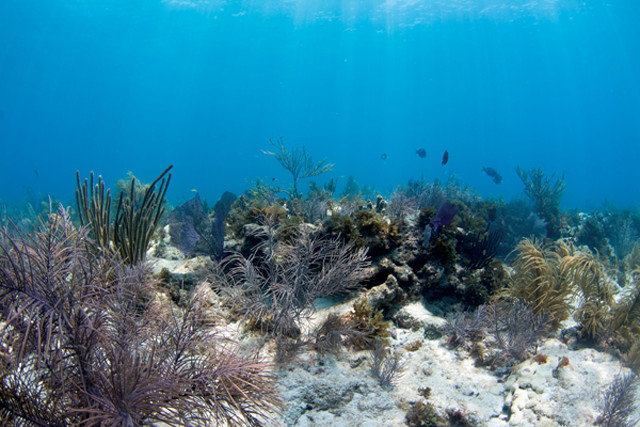
by Bethany Augliere Monday, July 17, 2017

Fish swim amid a coral reef off Islamorada in the Florida Keys. Credit: Bethany Augliere.
Coral reefs provide habitat for 25 percent of all marine life, support fishing and tourism economies, and protect shorelines from surging waves and storms. But since the 1970s, coral populations have been waning because of warming waters, coastal development and pollution. Recently, scientists studying several beleaguered reef systems have discovered an unexpected consequence of their decline — the seafloor around the reefs is eroding, leaving coastal communities more vulnerable to high winds and waves.
For the first time, scientists looked at regional-scale changes to seafloor depths around coral reefs, focusing on five sites in Florida, Hawaii and the U.S. Virgin Islands. “We’ve known coral reefs were struggling and degrading,” says biogeochemist Kimberly Yates, co-author of a new study published in the journal Biogeosciences. “What we didn’t know was how that’s affecting the seafloor around them.”
Corals secrete calcium carbonate skeletons that collectively form the rocky, three-dimensional structure of reef systems. As corals grow and die, their skeletons deteriorate to sand, which supplies tropical beaches and accumulates on the seafloor, typically keeping water depths around reefs relatively shallow. At the same time, however, winds, water currents and other forces erode sand from beaches and the seabed. According to the new study, coral growth and sand formation at some sites can’t keep up with seafloor erosion, causing the seabed to drop and water depths to increase.
For each reef system studied, Yates and her team gathered historic and modern seafloor depth data collected by NOAA, the U.S. Geological Survey and the U.S. Army Corps of Engineers, dating as far back as the 1930s. Until the 1950s, depth soundings were made using lead-weighted lines, and then later with sonar. Starting in the 1990s, measurements were made with airborne lidar, which relies on detecting pulses of laser light reflected off the seafloor.
The scientists compared the historic water depths to modern data to determine average elevation changes around the five reefs. In each reef system, they also noted how depth varied with habitat type, including isolated patch reefs, seagrass beds, reef rubble and sand, among others. From there, they modeled overall changes in seafloor volume.
Yates and her team found net drops in average seafloor elevation around each of the five reef systems ranging from 9 centimeters to almost a meter. Off Maui in Hawaii, where the most dramatic seafloor drops were seen, the team calculated a seafloor volume loss of 81 million cubic meters of sand, rock and other material — enough to fill New York’s Empire State Building nearly 80 times, Yates says.
What’s most alarming, she adds, is that, according to previous predictions, current water depths observed at the study locations should not have occurred until near 2100. Considering recent rates of sea-level rise between 2.8 and 3.6 millimeters per year observed near the five reefs, the researchers projected that, by 2100, seafloor erosion combined with sea-level rise will increase water depths two to eight times more than sea-level rise alone would.
“This is an important piece of work that hasn’t been done before … at this scale,” says geological oceanographer Albert Hine of the University of South Florida in St. Petersburg, who was not part of the study. “Everyone has been worried about the global reef community dying off, but no one considered that the substrate of reefs was actually eroding.”
There is some hopeful news, Yates notes. About 25 percent of the 60 habitat sites were not eroding and were actually showing some growth, mostly in remote regions. This was true, for example, in protected areas off Buck Island near St. Croix in the Caribbean, and in a portion of the upper Florida Keys. “The coral reefs are doing better in certain areas, but not quite enough to help out the entire system,” she says.
Yates and her team did not explore the specific causes of seabed elevation changes at each reef — an important avenue for future research, she says. Coral reefs are complex systems, so many factors — both natural and anthropogenic — could be at play.
Hine says that studies of the impacts of sea-level rise and climate change on coasts now need to include reef and seafloor erosion. “That wasn’t part of the discussion a few years ago, or even last year.”
© 2008-2021. All rights reserved. Any copying, redistribution or retransmission of any of the contents of this service without the expressed written permission of the American Geosciences Institute is expressly prohibited. Click here for all copyright requests.